Improvement of Drought Resistance of Osteospermum ecklonis Plants as a Physiological and Biochemical Response to Low Doses of UV-C Irradiation
Abstract
1. Introduction
2. Materials and Methods
2.1. Plant Material, Drought Treatments and Experimental Lay-Out
2.2. UV-C Irradiation Treatments
2.3. Growth and Development Assessments
2.4. Net CO2 Assimilation (As), Transpiration (E), Stomatal Conductance (gs) and Chlorophyll Fluorescence (Fv/Fm)
2.5. Colour Parameters
2.6. Relative Water Content (RWC)
2.7. Antioxidant Enzyme Activity
2.8. Electrolyte Leakage (EL) and Malondialdehyde (MDA)
2.9. Statistical Analysis
3. Results
3.1. Growth and Development
3.2. Net CO2 Assimilation (As), Transpiration (E), Stomatal Conductance (gs) and Chlorophyll Fluorescence (Fv/Fm)
3.3. Colour Parameters
3.4. Electrolyte Leakage (EL) and MDA
3.5. Antioxidant Enzyme Activity—SOD and CAT
4. Discussion
5. Conclusions
Author Contributions
Funding
Data Availability Statement
Conflicts of Interest
References
- Dole, J.M.; Wilkins, H.F. Floriculture: Principles and Species; Prentice-Hall Inc.: Hoboken, NJ, USA, 1999. [Google Scholar]
- Treder, J.; Nowak, J. The effect of irrigation frequency on growth, flowering and stomatal conductance of osteospermum ‘Denebola’ and New Guinea impatiens’ Timor’ grown on ebb· and-flow benches. Acta Agrobot. 2001, 54, 59–68. [Google Scholar] [CrossRef]
- Zollinger, N.; Kjelgren, R.; Cerny-Koenig, T.; Kopp, K.; Koenig, R. Drought responses of six ornamental herbaceous perennials. Sci. Hortic. 2006, 109, 267–274. [Google Scholar] [CrossRef]
- Cirillo, C.; Rouphael, Y.; Caputo, R.; Raimondi, G.; De Pascale, S. The influence of deficit irrigation on growth, ornamental quality, and water use efficiency of three potted Bougainvillea genotypes grown in two shapes. HortScience 2014, 49, 1284–1291. [Google Scholar] [CrossRef]
- Toscano, S.; Farieri, E.; Ferrante, A.; Romano, D. Physiological and biochemical responses in two ornamental shrubs to drought stress. Front. Plant Sci. 2016, 7, 645. [Google Scholar] [CrossRef]
- Toscano, S.; Ferrante, A.; Romano, D. Response of Mediterranean ornamental plants to drought stress. Horticulturae 2019, 5, 6. [Google Scholar] [CrossRef]
- Oraee, A.; Tehranifar, A. Evaluating the potential drought tolerance of pansy through its physiological and biochemical responses to drought and recovery periods. Sci. Hortic. 2020, 265, 109225. [Google Scholar] [CrossRef]
- Pang, C.-H.; Wang, B.-S. Oxidative stress and salt tolerance in plants. In Progress in Botany; Springer: Berlin/Heidelberg, Germany, 2008; pp. 231–245. [Google Scholar]
- Moller, I.M.; Jensen, P.E.; Hansson, A. Oxidative modifications to cellular components in plants. Annu. Rev. Plant Biol. 2007, 58, 459–481. [Google Scholar] [CrossRef]
- Chyliński, W.K.; Łukaszewska, A.J.; Kutnik, K. Drought response of two bedding plants. Acta Physiol. Plant. 2007, 29, 399–406. [Google Scholar] [CrossRef]
- Darras, A.I.; Demopoulos, V.; Bali, I.; Tiniakou, C. Photomorphogenic reactions in geranium (Pelargonium × hortorum) plants stimulated by brief exposures of ultraviolet-C irradiation. Plant Growth Regul. 2012, 68, 343–350. [Google Scholar] [CrossRef]
- Darras, A.I.; Demopoulos, V.; Bali, I.; Katsiloulis, O.; Kratimenou, E. Brief exposures of ultraviolet-C (UV-C) irradiation improves flowering of ornamental plants. Acta Hortic. 2013, 1002, 95–102. [Google Scholar] [CrossRef]
- Bridgen, M. Using ultraviolet-C light as plant growth regulator©. Acta Hortic. 2015, 1085, 167–169. [Google Scholar] [CrossRef]
- Urban, L.; Charles, F.; de Miranda, M.R.A.; Aarrouf, J. Understanding the physiological effects of UV-C light and exploiting its agronomic potential before and after harvest. Plant Physiol. Biochem. 2016, 105, 1–11. [Google Scholar] [CrossRef] [PubMed]
- Xie, Z.; Charles, M.T.; Fan, J.; Charlebois, D.; Khanizadeh, S.; Rolland, D.; Rousel, D.; Deschenes, M.; Dube, C. Effects of preharvest ultraviolet-C irradiation on fruit phytochemical profiles and antioxidant capacity in three strawberry (Fragaria × ananassa Duch.) cultivars. J. Sci. Food Agric. 2015, 95, 2996–3002. [Google Scholar] [CrossRef]
- Darras, A.I.; Skouras, P.J.; Assimomitis, P.; Labropoulou, C.; Stathas, G.J. Application of UV-C irradiation to Rosa × hybrida plants as a tool to minimise Macrosiphum rosae populations. Agronomy 2021, 11, 702. [Google Scholar] [CrossRef]
- Short, B.D.; Janisiewicz, W.; Takeda, F.; Leskey, T.C. UV-C irradiation as a management tool for Tetranychus urticae on strawberries. Pest Manag. Sci. 2018, 74, 2419–2423. [Google Scholar] [CrossRef]
- Darras, A.I.; Bali, I.; Argyropoulou, E. Disease resistance and growth responses in Pelargonium × hortorum plants to brief pulses of UV-C irradiation. Sci. Hortic. 2015, 181, 95–101. [Google Scholar] [CrossRef]
- Forges, M.; Vasquez, H.; Charles, F.; Chabane Sari, D.; Urban, L.; Lizzi, Y.; Bardin, M.; Aarrouf, J. Impact of UV-C radiation on the sensitivity of three strawberry plant cultivars (Fragaria × ananassa) against Botrytis cinerea. Sci. Hortic. 2018, 240, 603–613. [Google Scholar] [CrossRef]
- Gitz, D.C.; Liu-Gitz, L. How do UV photomorphogenic responses confer water stress tolerance? Photochem. Photobiol. 2003, 78, 529–534. [Google Scholar] [CrossRef]
- Robson, T.M.; Hartikainen, S.M.; Aphalo, P.J. How does solar ultraviolet-B radiation improve drought tolerance of silver birch (Betula pendula Roth.) seedlings? Plant Cell Environ. 2015, 38, 953–967. [Google Scholar] [CrossRef]
- Bian, S.; Jiang, Y. Reactive oxygen species, antioxidant enzyme activities and gene expression patterns in leaves and roots of Kentucky bluegrass in response to drought stress and recovery. Sci. Hortic. 2009, 120, 264–270. [Google Scholar] [CrossRef]
- Giannopolitis, C.N.; Ries, S.K. Superoxide occurrence in higher plants. Plant Physiol. 1977, 59, 309–314. [Google Scholar] [CrossRef]
- Aebi, H. Catalase in vitro. Method Enzymol. 1984, 105, 121–130. [Google Scholar]
- Karabal, E.; Yucel, M.; Oktem, H.A. Antioxidant responses of tolerant and sensitive barley cultivars to boron toxicity. Plant Sci. 2003, 164, 925–933. [Google Scholar] [CrossRef]
- Velikova, V.; Yordanov, I.; Edreva, A.J.P.S. Oxidative stress and some antioxidant systems in acid rain-treated bean plants: Protective role of exogenous polyamines. Plant Sci. 2000, 151, 59–66. [Google Scholar] [CrossRef]
- Álvarez, S.; Sánchez-Blanco, J. Changes in growth rate, root morphology and water use efficiency of potted Callistemon citrinus plants in response to different levels of water deficit. Sci. Hortic. 2013, 156, 54–62. [Google Scholar] [CrossRef]
- Saxena, S.C.; Joshi, P.K.; Grimm, B.; Arora, S. Alleviation of ultraviolet-C-induced oxidative damage through overexpression of cytosolic ascorbate peroxidase. Biologia 2011, 66, 1052–1059. [Google Scholar] [CrossRef]
- Loconsole, D.; Santamaria, P. UV lighting in horticulture: A sustainable tool for improving production quality and food safety. Horticulturae 2021, 7, 9. [Google Scholar] [CrossRef]
- Kondo, S.; Fiebig, A.; Okawa, K.; Ohara, H.; Kowitcharoen, L.; Nimitkeatkai, H.; Kittikorn, M.; Kim, M. Jasmonic acid, polyamine, and antioxidant levels in apple seedlings as affected by Ultraviolet-C irradiation. Plant Growth Regul. 2011, 64, 83–89. [Google Scholar] [CrossRef]
- Yu, X.; Zhang, W.; Zhang, Y.; Zhang, X.; Lang, D.; Zhang, X. The roles of methyl jasmonate to stress in plants. Funct. Plant Biol. 2018, 46, 197–212. [Google Scholar] [CrossRef]
- Đuric, M.; Subotic, A.; Prokic, L.; Trifunivic-Momcilov, M.; Milocevic, S. Foliar application of methyl jasmonate affects impatiens walleriana growth and leaf physiology under drought stress. Plant Signal. Behav. 2023, 18, 2219936. [Google Scholar] [CrossRef]
- Taiz, L.; Zeiger, E. Plant Physiology, 2nd ed.; Sinauer Associates, Inc. Publishers: Sunderland, MA, USA, 1998. [Google Scholar]
- Abreu, M.E.; Munné-Bosch, S. Salicylic acid may be involved in the regulation of drought-induced leaf senescence in perennials: A case study in field-grown Salvia officinalis L. plants. Environ. Exp. Bot. 2008, 64, 105–112. [Google Scholar] [CrossRef]
- Antonic, D.A.; Subotic, A.R.; Dragicevic, M.B.; Pantelic, D.; Milocevic, S.M.; Simonovic, A.D.; Momcilovic, I. Effects of exogenous salicylic acid on drought response and characterization of dehydrins in Impatiens walleriana. Plants 2020, 9, 1589. [Google Scholar] [CrossRef] [PubMed]
- Hussain, M.; Malik, M.A.; Farooq, M.; Ashraf, M.Y.; Cheema, M.A. Improving drought tolerance by exogenous application of glycinebetaine and salicylic acid in sunflower. J. Agron. Crop Sci. 2008, 194, 193–199. [Google Scholar] [CrossRef]
- Zulfiqar, F.; Chen, J.; Finnegan, P.M.; Younis, A.; Nafees, M.; Zorrig, W.; Hamed, K.B. Application of trehalose and salicylic acid mitigates drought stress in sweet basil and improves plant growth. Plants 2021, 10, 1078. [Google Scholar] [CrossRef]
- Zhang, X.; Yang, R.; Zheng, X.; Wang, Q.; Silvy, E.A.; Li, Y.; Han, Y.; Bi, Y.; Prusky, D. UV-C irradiation accelerated the deposition of suberin and lignin at wounds by activating phenylpropanoid metabolism in potato tubers. Sci. Hortic. 2023, 309, 111634. [Google Scholar] [CrossRef]
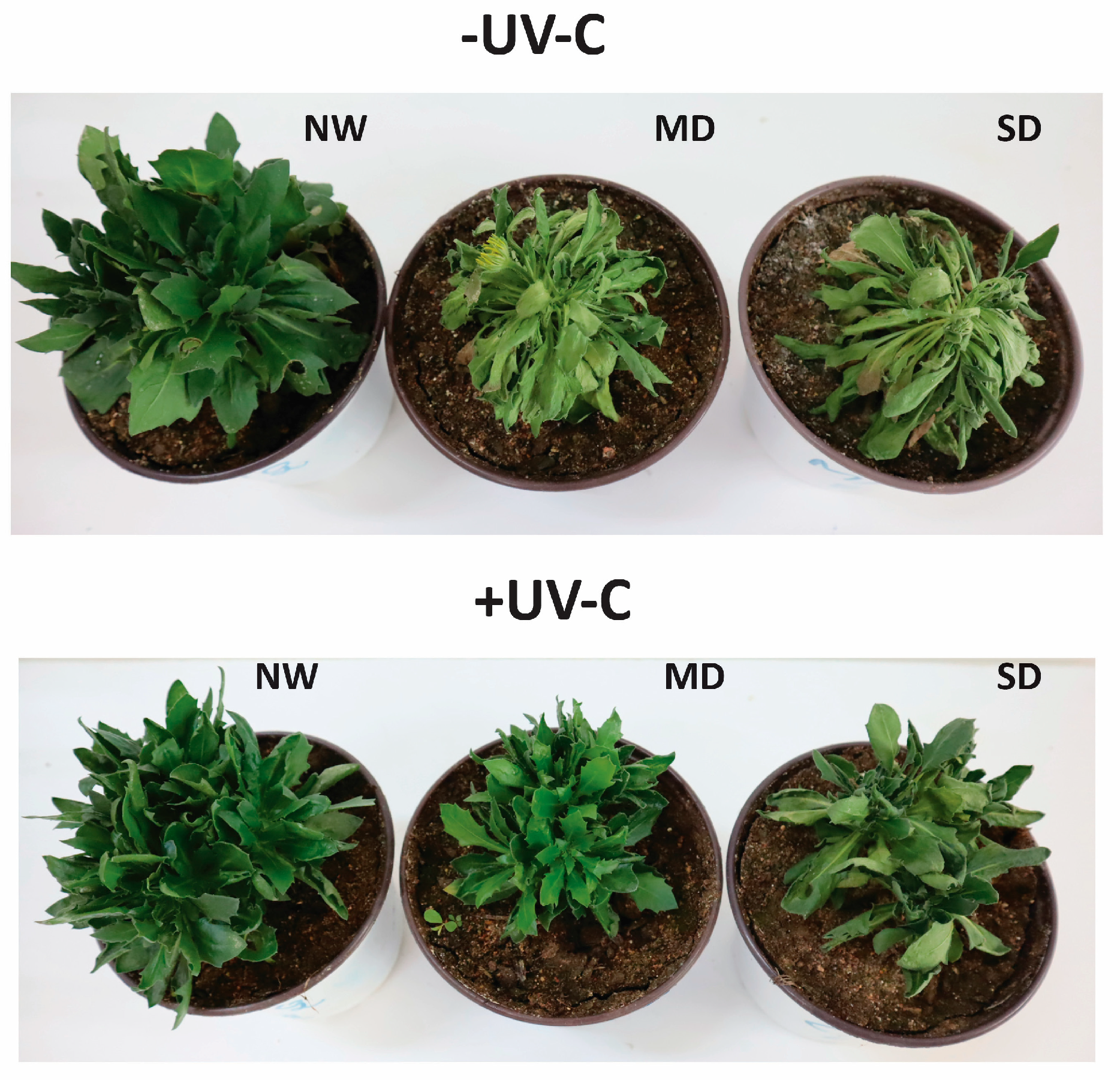
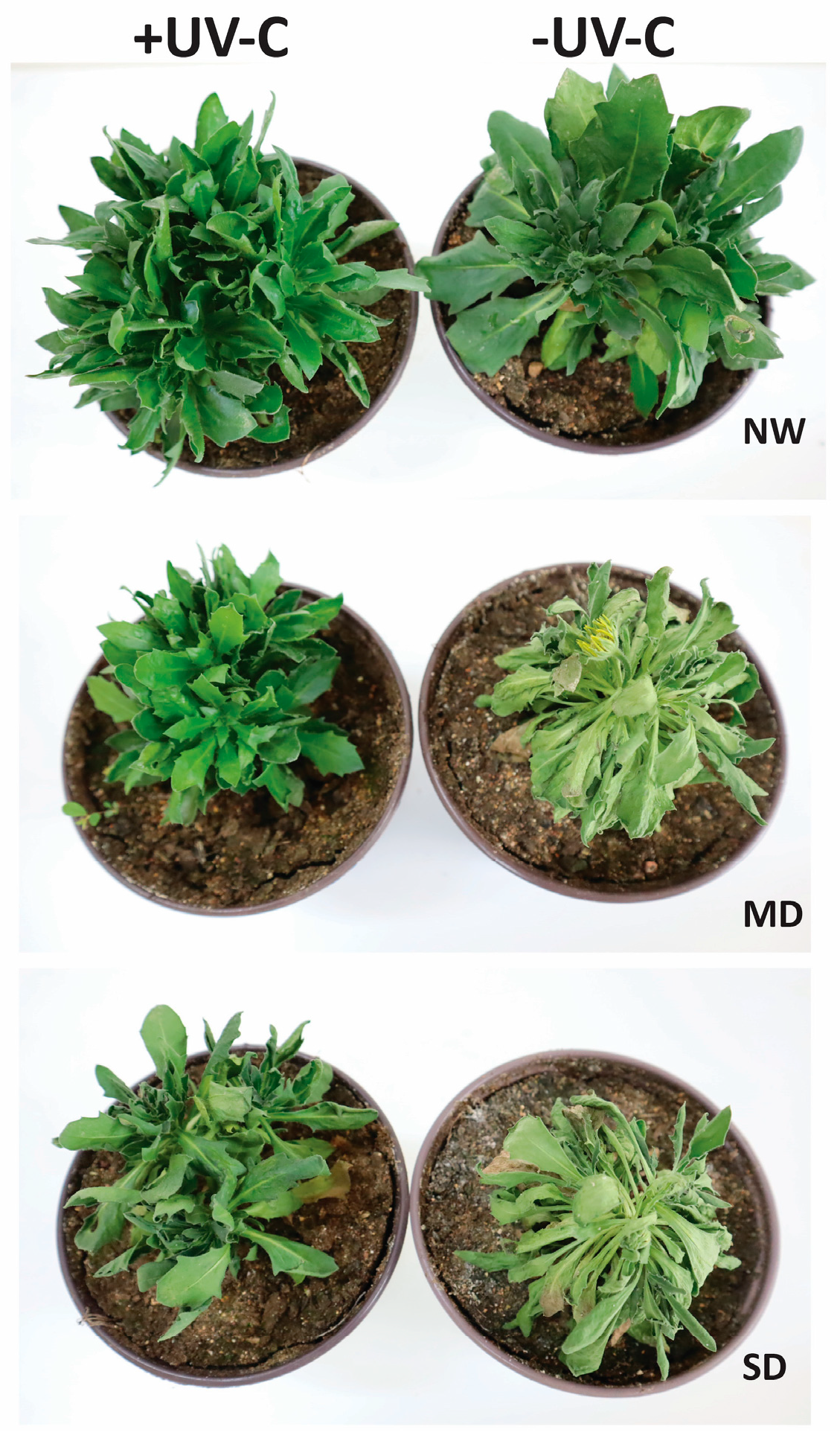
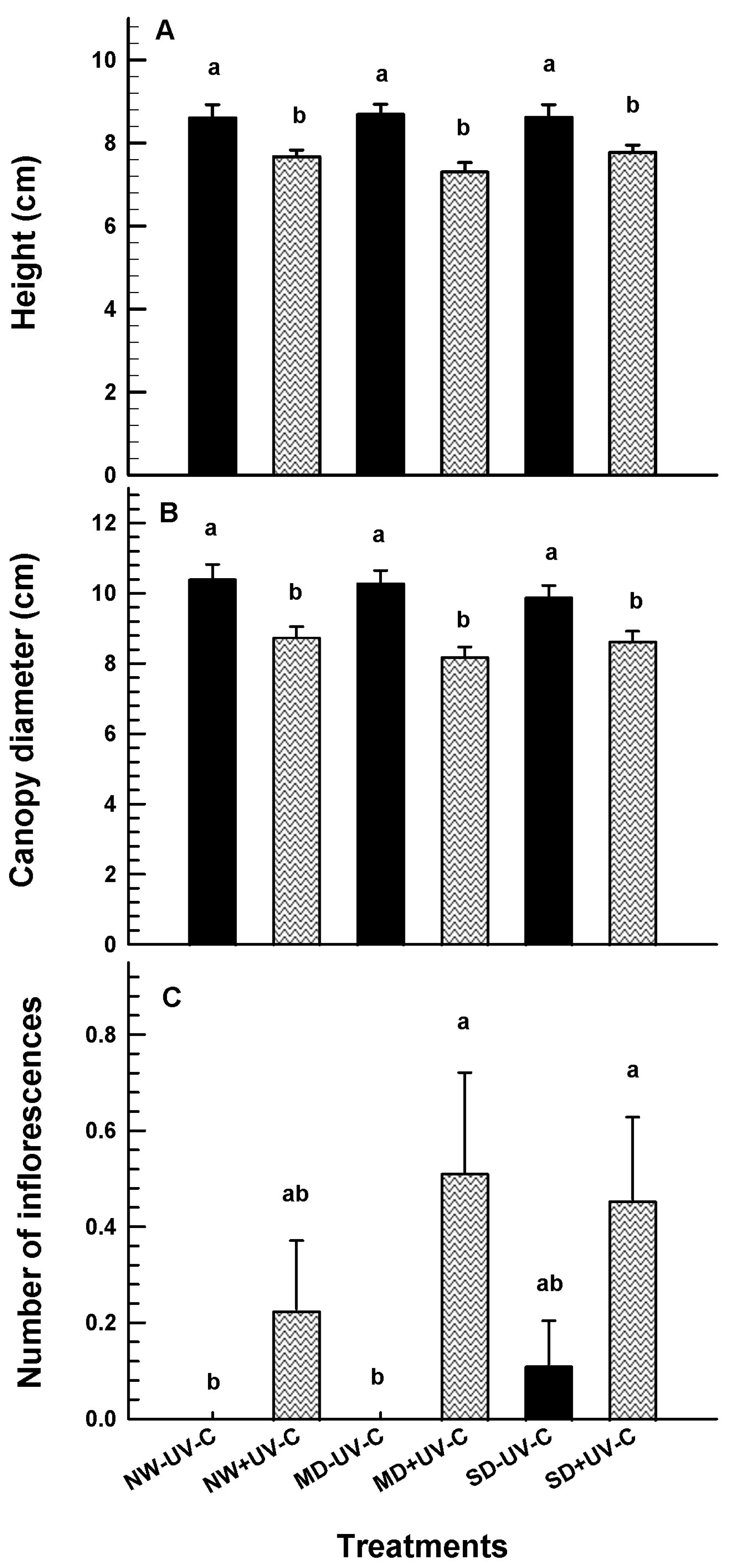
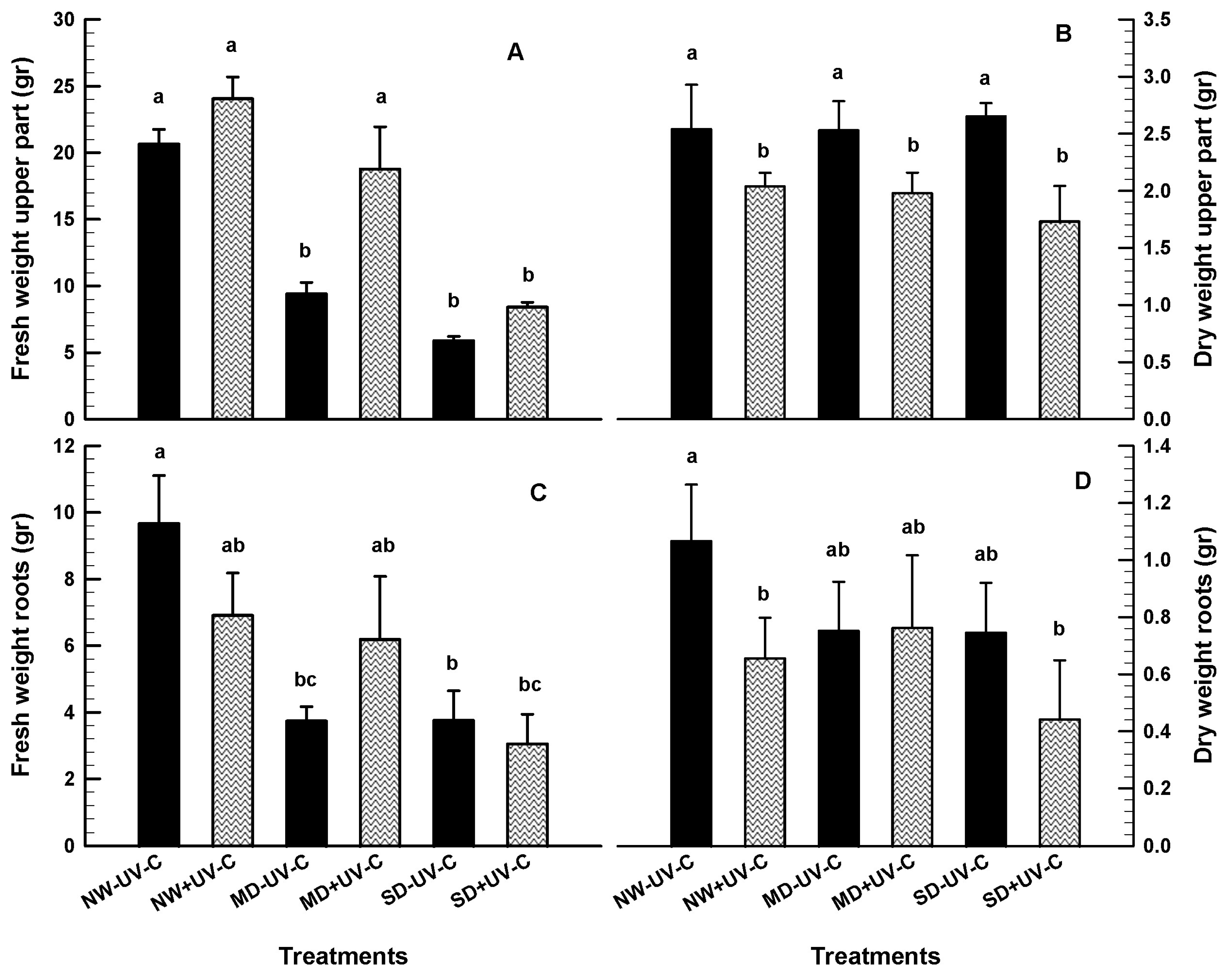
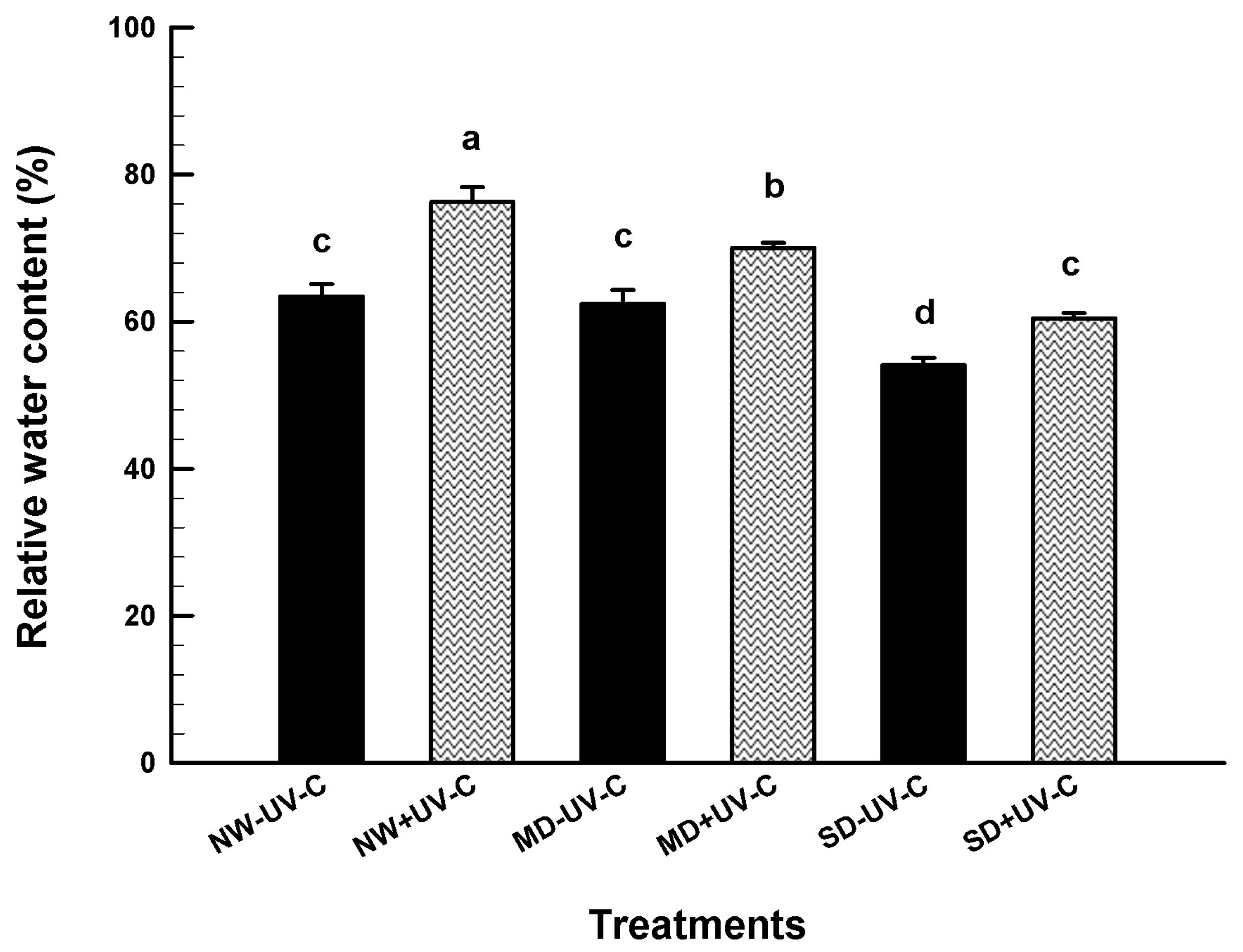
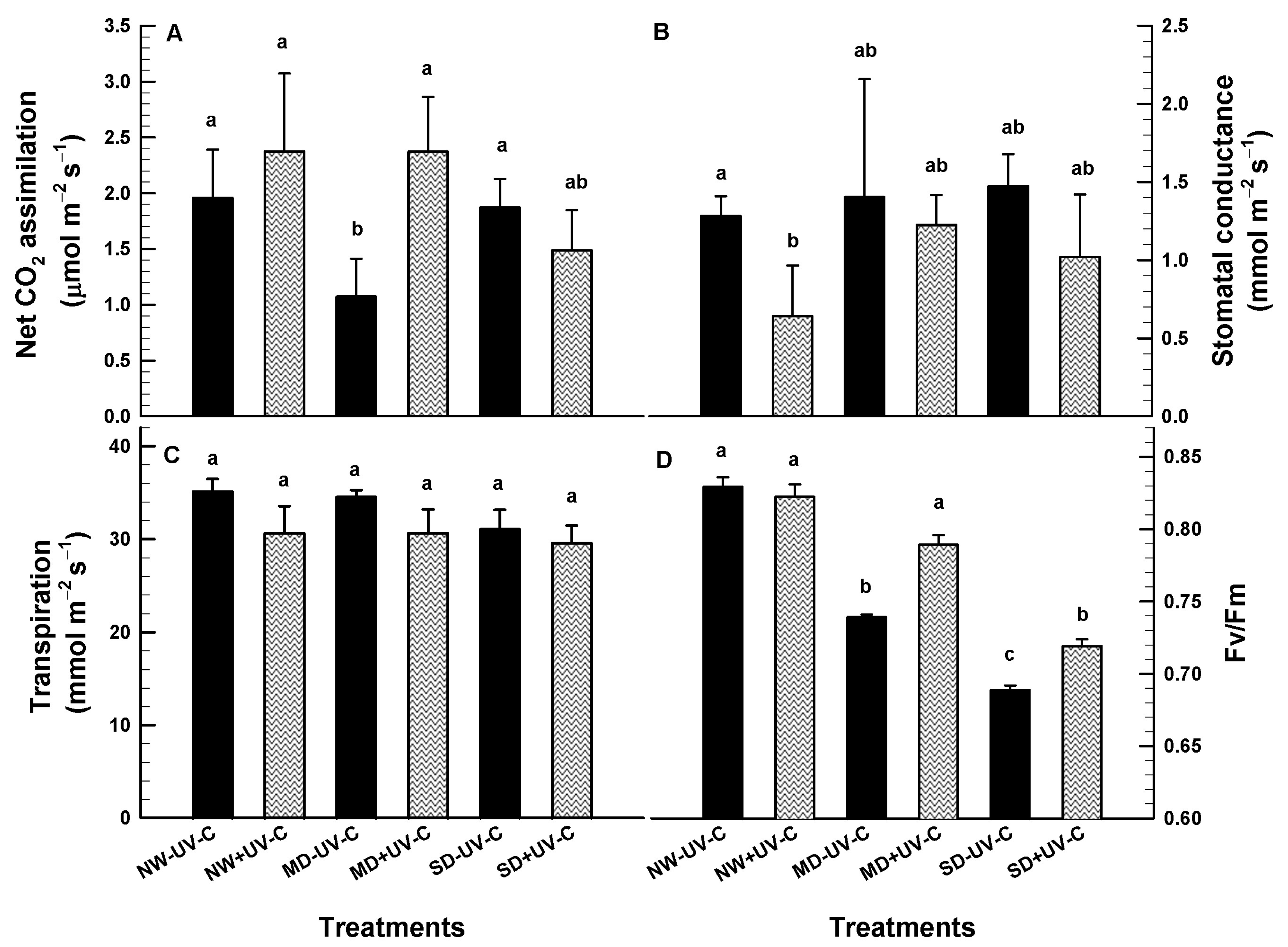
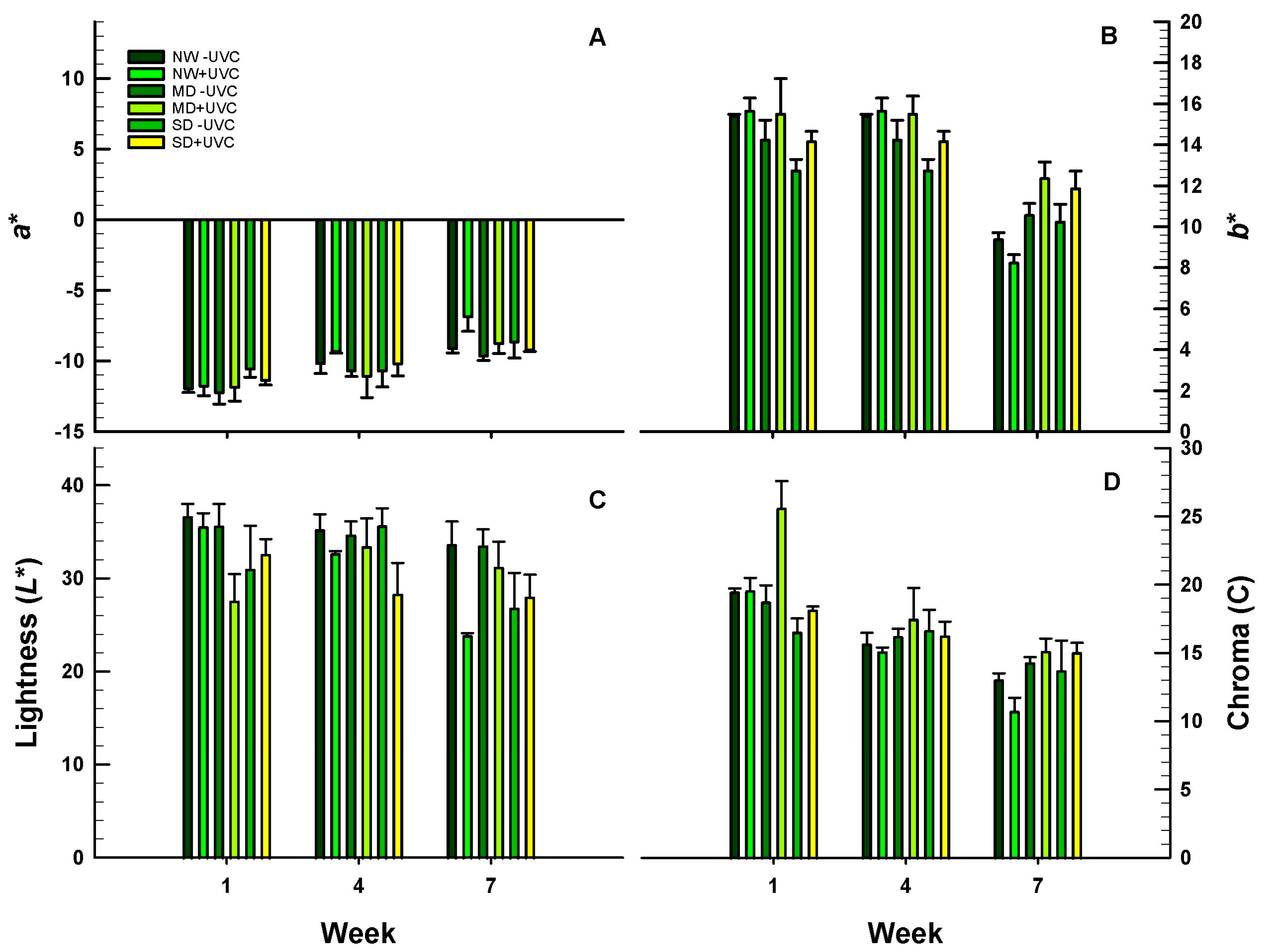
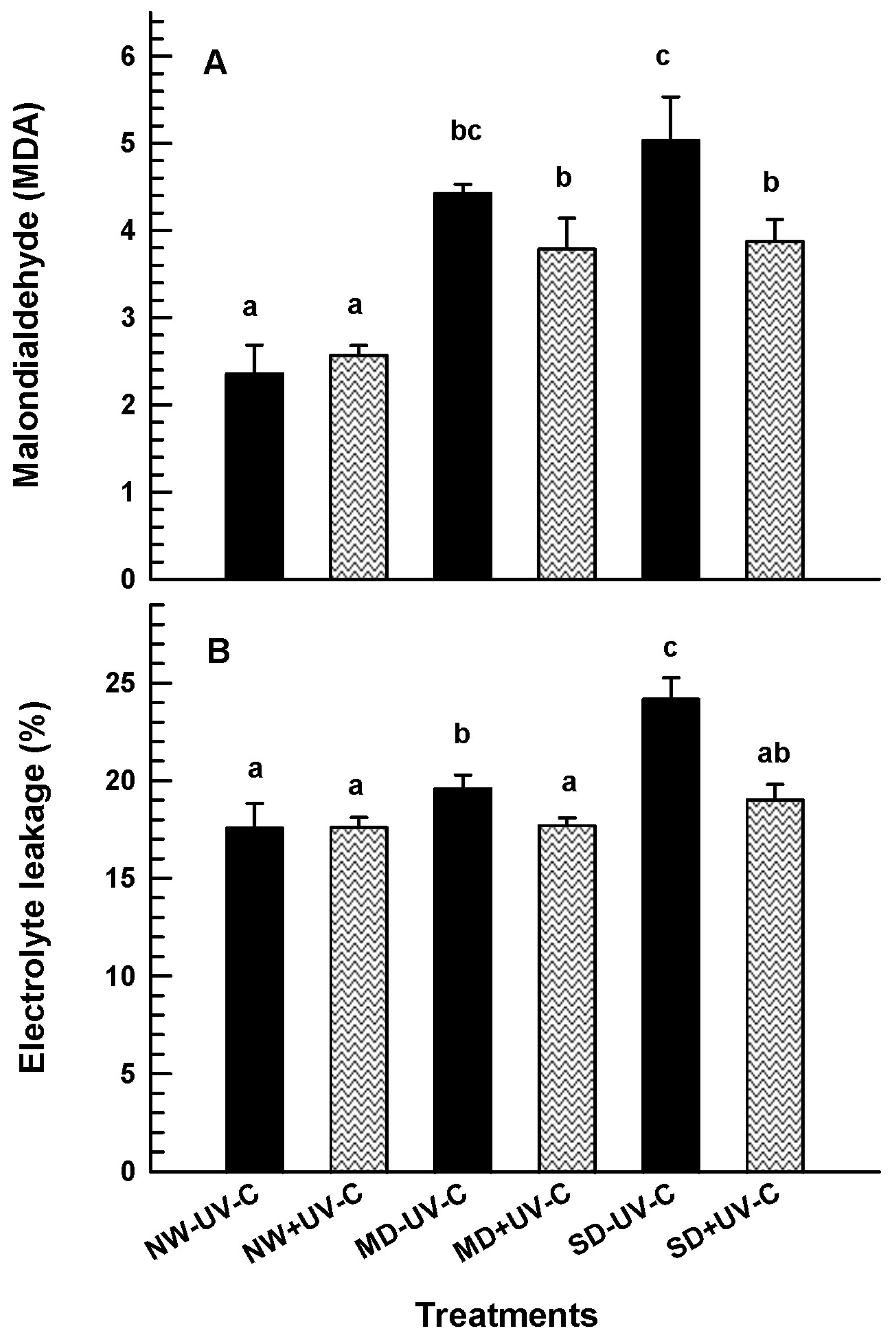
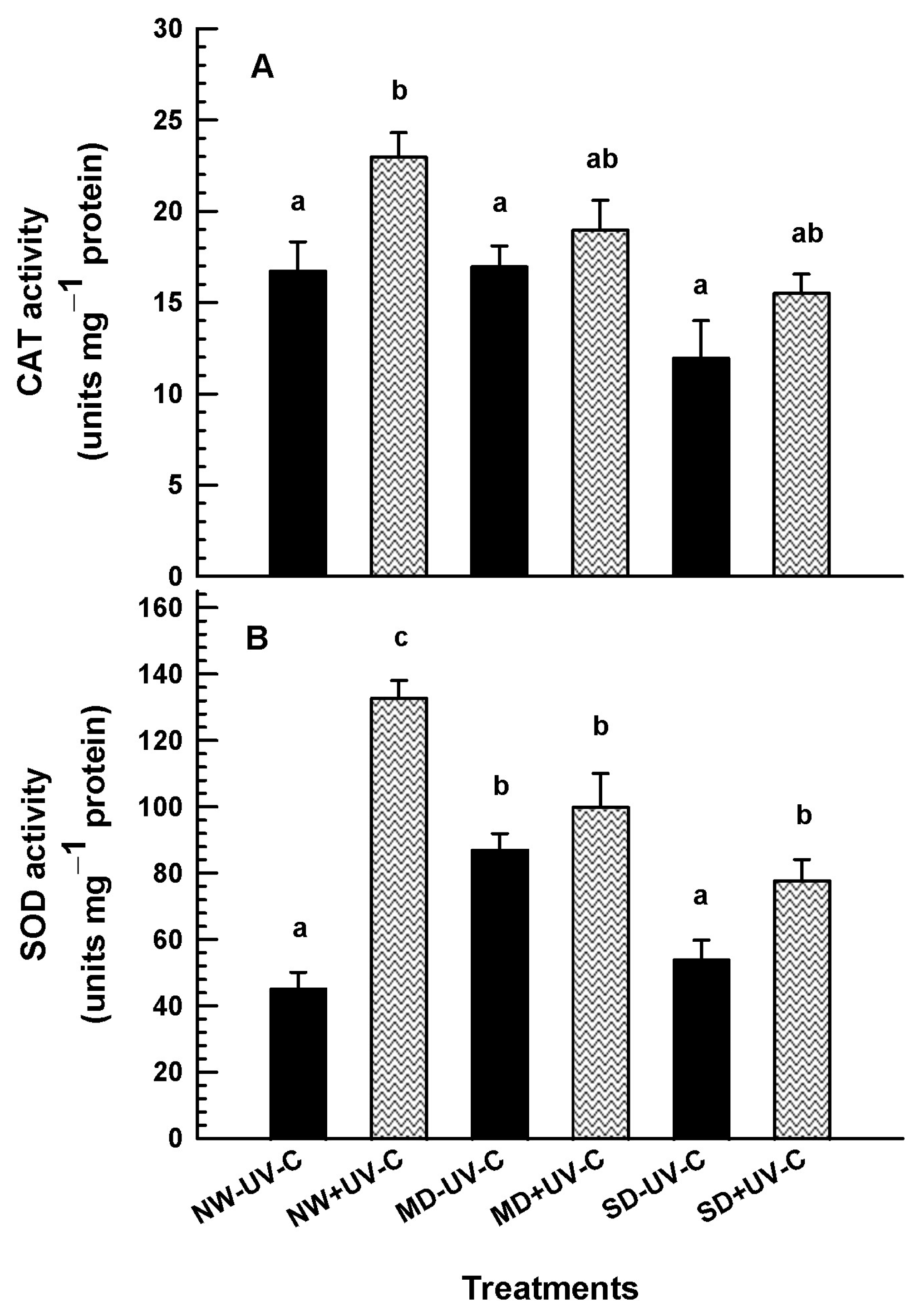
Disclaimer/Publisher’s Note: The statements, opinions and data contained in all publications are solely those of the individual author(s) and contributor(s) and not of MDPI and/or the editor(s). MDPI and/or the editor(s) disclaim responsibility for any injury to people or property resulting from any ideas, methods, instructions or products referred to in the content. |
© 2024 by the authors. Licensee MDPI, Basel, Switzerland. This article is an open access article distributed under the terms and conditions of the Creative Commons Attribution (CC BY) license (https://creativecommons.org/licenses/by/4.0/).
Share and Cite
Darras, A.I.; Kostriva, A.; Dimiza, K.; Apostolou, M.; Malamas, I.; Kargakou, V.; Kartsonas, E. Improvement of Drought Resistance of Osteospermum ecklonis Plants as a Physiological and Biochemical Response to Low Doses of UV-C Irradiation. Horticulturae 2024, 10, 189. https://doi.org/10.3390/horticulturae10020189
Darras AI, Kostriva A, Dimiza K, Apostolou M, Malamas I, Kargakou V, Kartsonas E. Improvement of Drought Resistance of Osteospermum ecklonis Plants as a Physiological and Biochemical Response to Low Doses of UV-C Irradiation. Horticulturae. 2024; 10(2):189. https://doi.org/10.3390/horticulturae10020189
Chicago/Turabian StyleDarras, Anastasios I., Anna Kostriva, Kallirroi Dimiza, Maria Apostolou, Ioannis Malamas, Vasiliki Kargakou, and Epaminondas Kartsonas. 2024. "Improvement of Drought Resistance of Osteospermum ecklonis Plants as a Physiological and Biochemical Response to Low Doses of UV-C Irradiation" Horticulturae 10, no. 2: 189. https://doi.org/10.3390/horticulturae10020189
APA StyleDarras, A. I., Kostriva, A., Dimiza, K., Apostolou, M., Malamas, I., Kargakou, V., & Kartsonas, E. (2024). Improvement of Drought Resistance of Osteospermum ecklonis Plants as a Physiological and Biochemical Response to Low Doses of UV-C Irradiation. Horticulturae, 10(2), 189. https://doi.org/10.3390/horticulturae10020189







